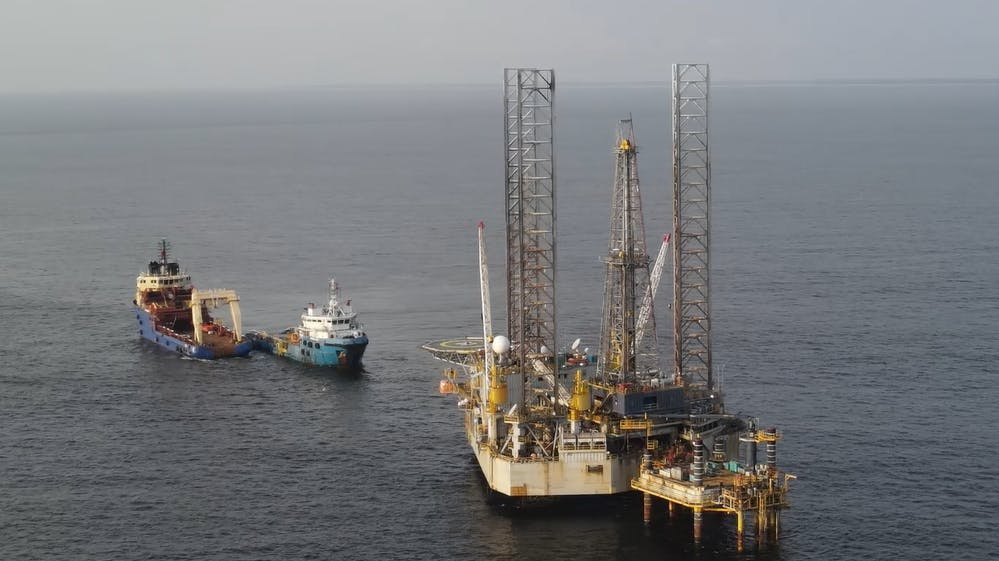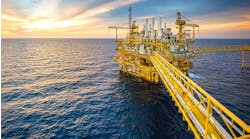By Jeremy Beckman, Editor-Europe
West Africa is firmly back on the industry’s radar following the deepwater exploration breakthroughs in Namibia and Côte d’Ivoire, and multiple offshore license awards and asset swaps this year from Republic of Congo north to Equatorial Guinea.
One of the longest-established operators in this central West African region is Perenco, which acquired its first offshore oilfield from Amoco in Gabon in 1992. Over the next 11 years the company grew its portfolio via further transactions and license acquisitions offshore and onshore Cameroon, Democratic Republic of Congo and Republic of Congo.
Today it continues to pursue incremental and greenfield development and exploration opportunities in all four countries, through deployments of in-house designed, new or converted platforms and workover rigs, an ultra-shallow water drilling barge, and other novel approaches. As CEO Armel Simondin explained: “Since Perenco’s inception over 30 years ago, our strategic focus has been bringing our expertise to fields, often overlooked or no longer material to the majors, but still of value to our host countries.
“Hubert Perrodo, the company’s founder, saw the opportunity in focusing on late life and marginal fields and since that time the in-house expertise and technical know-how has grown to what we do today. In particular, this allows us to perform combined oil and gas developments on mature fields, reducing the historical gas flaring rates. We also have the benefit of access to our sister company, Dixstone, based in Hoofddorp, the Netherlands. Dixstone is an affiliate of the Perenco Group, specialising in integrated solutions for the industry. We work closely with their 2,000-strong team on many projects.
“Being recognized as a trusted partner and able to point to a track record of success – both in terms of helping host countries develop their resources and meet their energy needs, but also in terms of making a significant economic and social contribution – hass been essential to remaining an active operator in the region. Our policy is to actively engage with all relevant stakeholders, not just in Central Africa, but also in all our subsidiaries, whether in the UK, Latin America or South-east Asia.”
Cameroon drilling barge
Since Perenco entered Cameroon in 1993, it has steadily expanded its activities to become the country’s leading oil and gas producer (currently over 90,000 boe/d). Milestone projects along the way have included the shallow-water Sanaga gasfield development in 2013, which would supply the onshore KPDC power plant that today generates 30% of Cameroon’s electricity. In 2018, the company, in partnership with state-owned Société Nationale des Hydrocarbures (SNH), initiated an LNG development 14 km (8.7 mi) from the port of Kribi that would deploy Golar LNG’s Hilli Episeyo, the world’s second floating offshore LNG vessel.
Late last year, Perenco and partners SNH and Addax Petroleum signed a new 20-year production-sharing contract for continued development of discovered fields in Cameroon’s offshore Rio del Rey basin. Since Perenco acquired operatorship of the concession over a decade ago, production has averaged 35,000 b/d, with the partnership seeking where possible to redevelop the existing infrastructure and enact other measures to stabilize output. The basin today accounts for around 70% of Cameroon's oil production.
Early in 2024, a five-well development drilling program started on the Kita Eden field in the northern part of the Rio del Rey basin, using a barge designed and constructed by Perenco and Dixstone to work alongside Dixstone’s LUG platform and configured for the conditions. No new activity had been attempted at the field since 1984, due to the area’s strong currents and ultra-shallow water (4 m/13 ft deep). According to Simondin, results from the wells completed to date have been above expectations and will lead to further drilling, allowing Kita Eden to sustain long-term production. Last year Perenco completed an eight-month development of the marginal South Kole Marine field in 30-50 m (98-164 ft) of water, 50 km (31 mi) offshore Cameroon, as a satellite to the partnership’s Tiko field. South Kole had been untouched since its discovery by a prior operator in the 1980s: the engineered solution involved innovations in the well architecture, pipelay and platform designs, Simondin noted.
South of Cameroon, Perenco Oil & Gas Gabon brought onstream the Hylia South West accumulation in the Mono offshore permit in October 2023, 10 months after discovering oil in the Ntchengue Ocean (NTO) reservoir and the Madiela carbonate reservoir via the HYSM-01 well. Dixstone’s jackup Banba performed follow-up appraisal drilling nearby earlier this year to improve understanding of the potential oil resources of the reservoirs in this area. For the Hylia SW development, Perenco installed a proprietary-design, self-elevating Fololo production platform and retained the discovery well, equipped with an electric submersible pump (ESP). Production heads through a 10-km (6.2-mi) pipeline to the established Hylia platform complex. Earlier, Perenco had proven oil with the Wamba discovery in the same permit.
“At Hylia SW, we aim to drill four additional wells next year, and complete offshore works to upgrade the process on the platform in order to accommodate the additional production,” Simondin said. “At Wamba, Perenco will install a new platform in early 2026 for a long-term exploitation campaign. We will drill two more wells that will give us the opportunity to better appraise the field before we envisage additional developments.”
Lightweight workover platform
Perenco originally developed the Fololo concept (“flower” in the Lingala language) for offshore workover operations in the Democratic Republic of Congo (DRC). Local subsidiary Perenco Rep’s traditional offshore tripod platforms were constrained for space for well maintenance: the Fololo was conceived as an alternative to conventional jacket-supported platforms in shallow water settings (less than 30 m/98 ft) that had to be installed using a heavy-lift barge.
The Fololo comprises relatively lightweight floating pontoons and legs that can self-elevate to the required height, forming a 20 x 20-m (65.6 xz 65.6-ft) mini-platform that can accommodate a crane and all equipment/materials needed for well interventions. Workover teams onboard can install ESPs without the need of further assistance. The first system, set down on the Mibalé field offshore the DRC in early 2017, was used to double production to 5,000 b/d. Perenco went on to install further Fololos at its fields offshore Cameroon and Gabon, and at the Motoba field in the DRC for oil production boosting. An 11th Fololo was added last year at Mibalé for intervention on a water injector. Some of the systems have also been used to support offshore compression and electrification projects. “We are currently working on a way to develop the design to work in deeper waters,” Simondin added, “in the 40-60 m [131-197 ft] water depth range, which will allow us to support redevelopment on more fields.”
Another Perenco subsidiary in the DRC, Muanda International Oil Company (MIOC), drilled two exploration wells at the start of this year using the Dixtone jackup Nuada, leading to the country’s first new offshore discovery in nearly three decades. The Moke-East well, drilled in the coastal basin between the Lukami and Motoba fields, penetrated a 24-ft (7.3-m) net oil-bearing column (the other well on the Lukami South prospect was P&A’d as sub-commercial). In February the Nuada transferred to the GCO field for a 12-well development drilling program targeting added production of 2,000 b/d and improved recovery from the Pinda formation reservoirs.
In between the DRC and Gabon, Perenco is also active offshore Republic of Congo. Here, Perenco Congo has been developing the Boatou field which had remained untouched since its discovery by Elf in 1984, 55 km (34 mi) offshore Pointe-Noire and 7 km (4.34 mi) from nearby infrastructure at the Likouala field. Boatou has estimated in-place reserves of 73 MMbbl. “Simply put, there was no reasonable and smart enough way to develop the field before Perenco Congo’s development plan,” Simondin explained. “The water depth is such that it requires relatively heavy infrastructure, which we managed to create with a MOPU – a converted drilling jackup with wellheads and some process capability, which is tied to the Likouaka field and also powered from Likouala.” The first four wells were put into production by May 2023, at 4,500 b/d. Other partners in the project are state-owned SNPC and PetroCongo.
Another recent project involved Dixstone converting a drilling rig to the Tchendo 2 MOPU for power production offshore Republic of Congo. The program included installation of three Solar gas turbines consuming up to 10 MMcf/d (supplied from nearby offshore fields), extensive associated electrical equipment, decommissioning of drilling equipment, integrity, revamping and safety-critical work. The three turbines can generate 27 MW: Perenco has also added a wellhead platform for new infill wells that should produce an additional 10 MMbbl from the Emeraude, Likoula and PNGF fields, all in shallow water 25 km (15.5 mi) from Pointe Noire.
“Today all the gas comes from nearby fields,” Simondin said, “and as a result of Tchendo 2, we are self-sufficient and do not draw any more power from the onshore plant which supplies the country’s network, thus freeing additional power for the population. Production from those fields is expected to last as long as we take good care of it. This is the principle of Perenco’s management of mature fields.”
In the same area, Shearwater Geoservices completed a 3D seismic survey late last year for Perenco Congo and Congorep, the joint venture between Perenco and SNPC, over the offshore Tchendo II, Emeraude, Tchibouela II and Marine XXVIII permits. The survey, commissioned following oil discoveries on neighboring concessions, targeted the pre-salt layer at depths between 2,000 and 3,000 m (6,562-9842 ft). The seismic acquisition vessel deployed a 6,000-m (19,685-ft) long, 900-m (2,953-ft) wide cable array with a rotation radius of 4 km (13,123 ft). Various obstacles had to be addressed, including the need to work around certain platforms and local shipping, and variable weather. “The Congolese basin is indeed quite congested,” Simondin confirmed, “and it has taken some organization to define the best seismic lines while also managing fishermen and other offshore vessels. However, with the support of our contractors, it went very smoothly and exactly to schedule. The processing is ongoing, and we are looking forward to providing updates in due course.”








